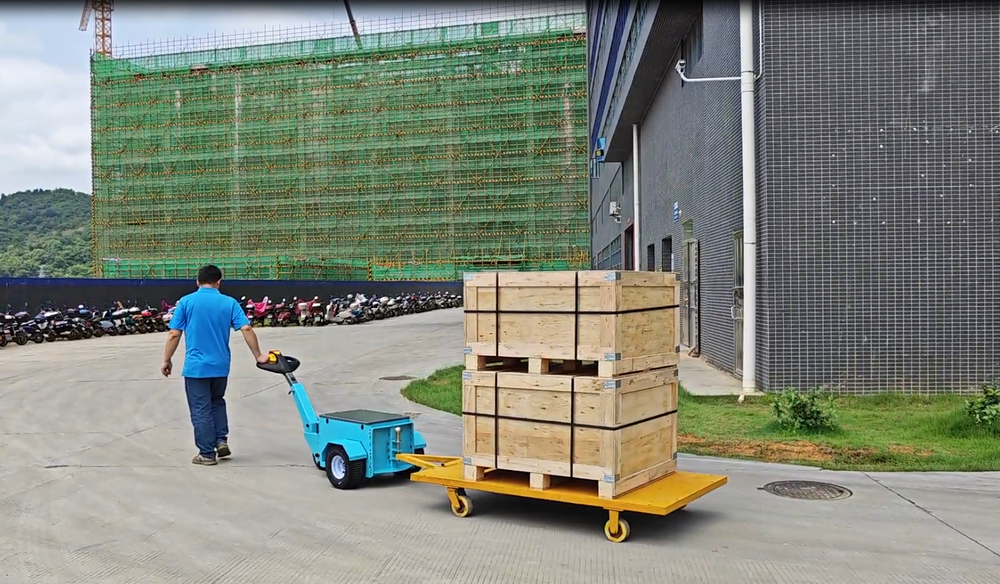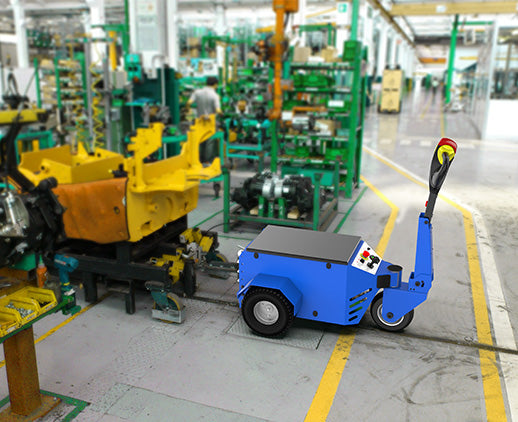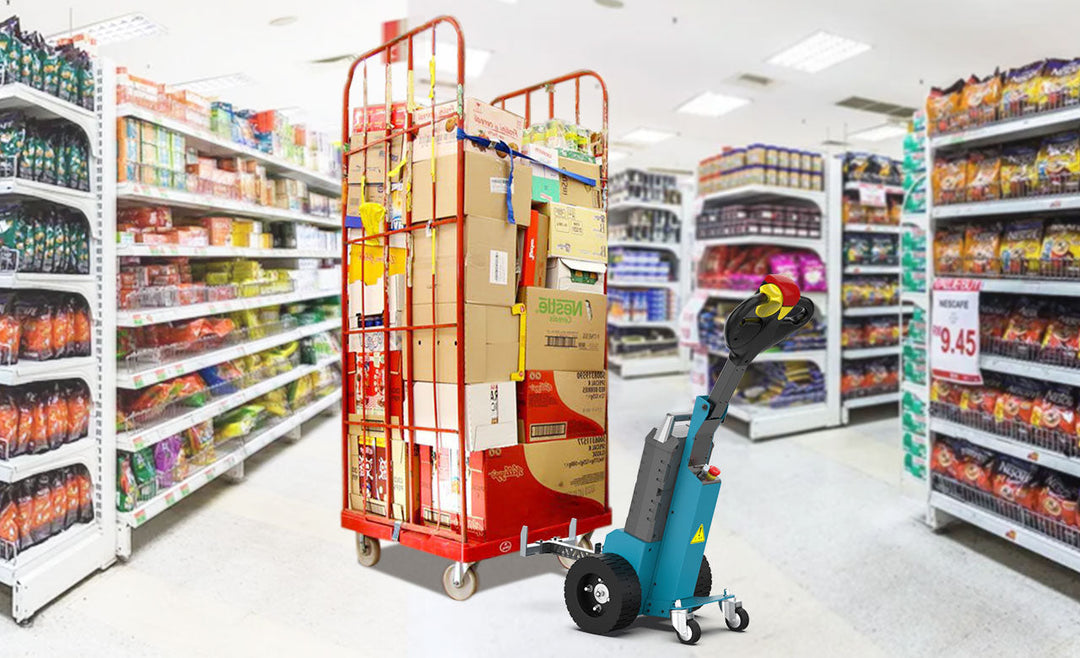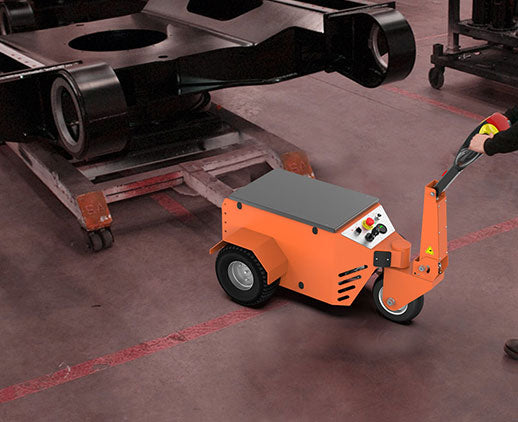Manufacturers need material handling equipment that can provide powerful movement, accurate movement, and maximized maneuverability. In work environments that require frequent movement but not lifting, the advantages of electric tuggers will be more prominent.Therefore, upon initial analysis, it is clear that choosing an electric tugger is more cost-effective, making it a more ideal choice.
What Are the Differences Between a Forklift and an Electric Tugger?

Forklifts are mainly used in warehouses, manufacturing plants and distribution centers for lifting and stacking pallets, transporting raw materials and loading and unloading trucks. The core function is to lift heavy objects vertically, which is a completely different feature from electric
tuggers. Moreover, most forklifts are equipped with a hydraulic system-based lifting mechanism, which is more stable and effective in handling tons of goods and balancing weights.
However, a big disadvantage is that it requires professionals to drive. If not, this will greatly affect the professionalism and safety of the personnel. Therefore, most logistics warehouses do not choose forklifts as the main means of transportation for goods.

However, electric tuggers are used in airports, hospitals and large warehouses to move luggage carts, transport medical supplies and transport goods over long distances, making them ideal for towing carts or tuggers over long distances.
Its core function is mainly horizontal movement, which is the biggest difference between forklifts and electric tuggers. Compared with forklifts, electric tuggers can be easily used by anyone, so electric tuggerss are currently more popular.
In particular, the electric tuggers launched by GYPOT are different from general brands. On the basis of high-quality performance, they also add many additional functional designs, such as warning horns, anti-crushing buttons, machine creep coupling assistance, etc. At the same time, the electric tugger itself comes with a high-quality motor design, which uses high torque to tow heavy wheeled loads, and with a hitch, it can be easily connected to a cart or tugger.
Comparison of Pros and Cons: Electric tugger VS. Forklift
| Main Feature |
Forklift |
Electric Tugger |
| Lifting Capacity |
Up to 5 tons or more |
Not applicable |
| Towing Capacity |
Limited |
Up to 10 tons |
| Maneuverability |
Limited in tight spaces |
Highly maneuverable in narrow aisles |
| Speed |
Up to 8 mph |
Up to 6 mph |
| Energy Efficiency |
Moderate (depends on fuel type) |
High (electric powered) |
| Maintenance Cost |
High due to complex systems |
Lower due to fewer moving parts |
| Initial Purchase Cost |
$20,000 to $50,000 or more |
$10,000 to $30,000 |
| Ideal Environments |
Warehouses, manufacturing plants, distribution centers |
Airports, hospitals, large warehouses |
| Operation |
Requires skilled operators |
Easier to operate |
| Usage |
Lifting and stacking heavy items |
Towing wheeled carts over long distances
|
How to choose better?
Clear purpose. If your operation involves lifting and stacking heavy objects, and requires strong lifting capacity to move pallets and large containers, choose a forklift. If your operation requires frequent long-distance transportation of goods with high mobility, please choose an electric tugger.
Specific needs of the operation. Don't stick to choosing only one. Since most of these usage scenarios are in warehouses, distribution centers and other locations, then perhaps we can choose fewer forklifts and more electric tuggers. This combination is the most cost-effective and will not harm interests by giving up vertical movement.
Consider additional functions. Due to site limitations, safety and stability need to be given priority, which requires additional functions to further support. Since there will not be many forklifts, electric tuggers are mainly considered for the time being. You can give priority to the electric tuggers launched by GYPOT, which are fully functional. This choice is in line with the operational needs and budget, and can maximize efficiency and productivity.

 Forklifts are mainly used in warehouses, manufacturing plants and distribution centers for lifting and stacking pallets, transporting raw materials and loading and unloading trucks. The core function is to lift heavy objects vertically, which is a completely different feature from electric tuggers. Moreover, most forklifts are equipped with a hydraulic system-based lifting mechanism, which is more stable and effective in handling tons of goods and balancing weights.
Forklifts are mainly used in warehouses, manufacturing plants and distribution centers for lifting and stacking pallets, transporting raw materials and loading and unloading trucks. The core function is to lift heavy objects vertically, which is a completely different feature from electric tuggers. Moreover, most forklifts are equipped with a hydraulic system-based lifting mechanism, which is more stable and effective in handling tons of goods and balancing weights. However, electric tuggers are used in airports, hospitals and large warehouses to move luggage carts, transport medical supplies and transport goods over long distances, making them ideal for towing carts or tuggers over long distances.
However, electric tuggers are used in airports, hospitals and large warehouses to move luggage carts, transport medical supplies and transport goods over long distances, making them ideal for towing carts or tuggers over long distances.








